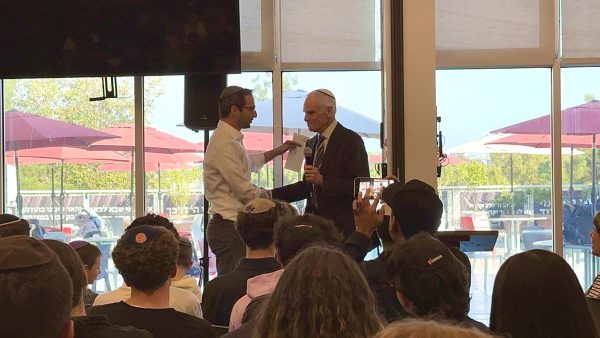Art exhibit opens window on life before, during and after Holocaust
Last May, students presented a two-day program showcasing the work of survivor David Labkovski
October 31, 2022
It looked like a regular Shalhevet art show, with some paintings displayed on easels in the front of the Beit Midrash, while many others lined the room’s north-wall bookshelf. But this time the artworks weren’t by students.
Instead, they were the work of David Labkovski, a Holocaust survivor who had been imprisoned in a Russian Gulag, and who after the war painted as a way to tell the story of his life before, during and after those times.
The program was led by now-senior Amalia Abecassis, who since ninth grade has worked outside of school as a docent for the David Labkovski Project and is now an International Ambassador for the organization.
Labkovski’s art was shown both in person and on a website that Amalia and other members of the project had curated. Amalia, who is interested in research on where art comes from and possibly studying art history in college, said it’s becoming especially important to exhibit works like Labkovski’s to keep memory of the Holocaust alive.
“There aren’t survivors for much longer, and so because of that, we’re forced to turn to different ways of telling the Holocaust and making sure that people never forget about it,” Amalia said. “And the one way that I’ve been able to tell this story is through art …, being an advocate and doing things so that stories and experiences aren’t forgotten.”
Some of Labkovski’s paintings were shown on a TV in the Beit Midrash and others as lifesize replicas mounted on easels. The exhibit was presented to different grades over two days last May while seniors were on their Poland-Israel trip.
Also presenting were then-juniors Tehilla Fishman and Alexandra Hoffman, who are docents with the Labkovski project and who explained one painting each.
Alexandra showed a painting of Labkovski’s wife’s family home pre-war, in Vilna, Lithuania. It was painted in light colors and showed family members going about their day. Later in the presentation, Amalia contrasted this painting with another one that depicted the same home during the war – in grimmer shades, as the family hauled off belongings as they were led to a ghetto.
Labkovski also painted self-portraits, where he used color to depict his own feelings, Amalia explained. In pre-war and early war paintings, he painted his eyes as dark blue, transitioning into a grayness – almost completely black – during the Gulag period, as if they were no longer there and could not see.
After the war, Labkovski returned his eye color to a lighter tint of the original blue. This demonstrated his personal transition back to peacetime and showed that although he would never be able to return to the same vivid color as life had been before the war started, he had refound himself and can see particular parts of himself again.
Students found the paintings moving and enlightening.
“Even the most minute of details in the paintings had such monumental meanings,” said then-sophomore Kyla Zachary in an interview last May.
One painting, Kyla said, “really spoke to me. It was a bunch of Jews that they were walking to their deaths, essentially to the forest where the Nazis would shoot them. And the whole picture was black-and-white and gray tones, maybe dark greens, very creepy.
“And then the one contrasted figure [in color] was this little kid in her mother’s arms,” Kyla said, “and it was just like heartbreaking, honestly, to see that the artist … had depicted that there was no life left in anything but the innocent child, which is so sad to think about.”
In many paintings, he painted children more prominently and with more vibrant colors to generally demonstrate a sense of humanity and life in the paintings while the environment was usually painted with darker and somber colors. The children were often reaching outwards, asking the audience to come and help them.
Then-junior Josh Askari found these especially moving.
“The child sort of being carried and then sort of looking back with an outstretched arm – I mean that one really sort of touched me,” said Josh in an interview May 13. “Because I think, like they said, the child really looked out from the canvas and sort of like begging for help, right?
“It sort of even seemed as if she knew what was going to happen – outstretching her arms, saying it – someone, anyone, help me.”
Amalia said her own favorite piece was the one of the pre-war Jewish community.
“It’s the first piece I always show,” said Amalia in an interview May 12. “It’s a piece that basically shows life before the war, and it’s just showing people doing their own things, everyday life in Vilna.
“You see like the synagogue,” she continued. “I just I love it because it shows the thriving community, and the life of Judaism and how strong and united the community was.”
Labkovski’s actual paintings are housed in three collections: the David Labkovski Museum of Jewish Life in Ramat Gan, Israel; that of Barbara Barishman in Los Angeles and that of Patricia Flaum in Johannesburg. The Labkovski project has had replicas of his work printed on canvas for exhibits in the U.S. and elsewhere.
Beyond Shalhevet, Amalia and other members of the project have also presented at Chapman University in Orange County, at online events she said were attended by hundreds, and for California State Sen. Henry Stern.
Separately from the Labkovski project, Amalia taught two minimester classes for seniors last year with history teacher Dr. Keith Harris, using a curriculum she created to discuss Holocaust art that was stolen.
When presenting with the Labkovski project, Amalia said she tries to offer two main takeaways.
“The first one is really to try to get students and like the younger generations to see art differently, because most people just see it as like this object that’s hung up in a museum or like just paint on canvas, and they don’t really see it as more,” Amalia said.
“And including myself – I used to be like that and I actually hated going to museums. But you know, when you look at it differently, when you see it as something that’s always been with us – that’s like part of our history, that tells a story, that is very valuable – then you understand its potential and how much it has played a role throughout time.”
Josh Askari also took away from the presentation to not take for granted the opportunities people today have with survivors.
“Next time I get a chance to listen to a survivor’s story I should really really take it and sort of just really take it in cause who knows how many times I can get that opportunity again.”


















